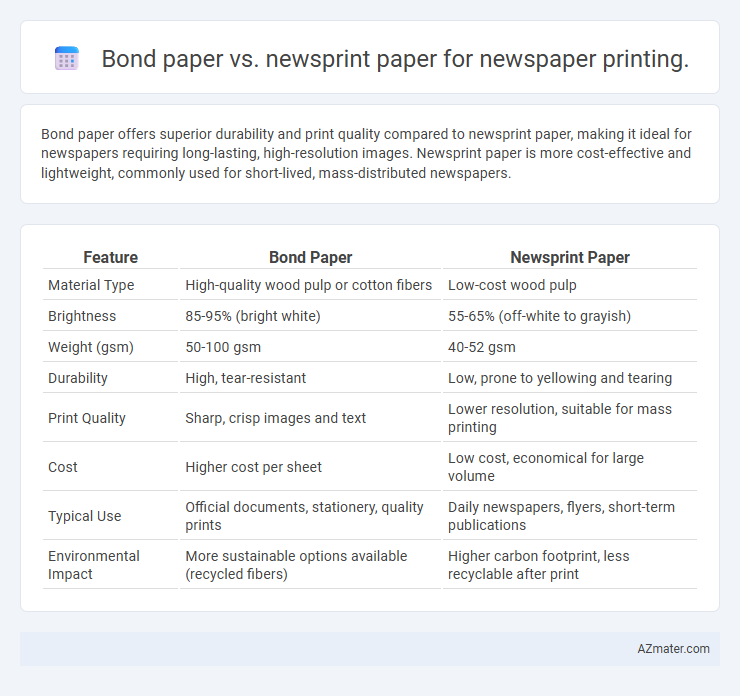Bond paper offers superior durability and print quality compared to newsprint paper, making it ideal for newspapers requiring long-lasting, high-resolution images. Newsprint paper is more cost-effective and lightweight, commonly used for short-lived, mass-distributed newspapers.
Table of Comparison
| Feature | Bond Paper | Newsprint Paper |
|---|---|---|
| Material Type | High-quality wood pulp or cotton fibers | Low-cost wood pulp |
| Brightness | 85-95% (bright white) | 55-65% (off-white to grayish) |
| Weight (gsm) | 50-100 gsm | 40-52 gsm |
| Durability | High, tear-resistant | Low, prone to yellowing and tearing |
| Print Quality | Sharp, crisp images and text | Lower resolution, suitable for mass printing |
| Cost | Higher cost per sheet | Low cost, economical for large volume |
| Typical Use | Official documents, stationery, quality prints | Daily newspapers, flyers, short-term publications |
| Environmental Impact | More sustainable options available (recycled fibers) | Higher carbon footprint, less recyclable after print |
Introduction to Newspaper Printing Paper Choices
Bond paper offers higher durability, opacity, and print quality, making it suitable for premium newspaper editions or special inserts. Newsprint paper, characterized by its lightweight, low cost, and quick absorbency, remains the industry standard for daily newspapers with high circulation. Selecting between bond and newsprint depends on factors like budget, print longevity, and desired image sharpness in newspaper printing.
What is Bond Paper?
Bond paper is a high-quality, durable writing paper typically made from cotton or wood pulp, known for its strength and smooth finish. It features a higher weight and opacity compared to newsprint, making it suitable for official documents, letterheads, and forms requiring sharp print clarity. Unlike newsprint, bond paper is less absorbent and offers better resistance to ink bleed, resulting in crisp, professional-looking newspaper inserts or special editions.
What is Newsprint Paper?
Newsprint paper is a low-cost, non-archival paper primarily used for printing newspapers, characterized by its lightweight, high porosity, and rough texture, which absorbs ink quickly for fast-drying printing presses. Typically made from wood pulp, newsprint is less durable and has a lower brightness and opacity compared to bond paper, making it unsuitable for long-term preservation but ideal for high-volume, short-lifecycle newspaper production. Bond paper, in contrast, is heavier, smoother, and more durable, often used for printing documents requiring higher quality and longevity, such as magazines or office papers.
Key Differences Between Bond Paper and Newsprint
Bond paper offers higher durability, a smoother texture, and better ink absorption compared to newsprint, making it ideal for premium newspaper editions or documents requiring longevity. Newsprint is lightweight, cost-effective, and designed for high-speed printing with quick ink drying, suitable for daily newspaper production with frequent recycling. The key differences lie in their fiber content, weight, brightness, and price, where bond paper uses higher-quality fibers and has greater brightness and thickness than the more porous and less expensive newsprint.
Print Quality Comparison: Bond vs Newsprint
Bond paper delivers sharper image resolution and richer color reproduction compared to newsprint, which tends to absorb more ink causing blur and diminished detail. Newsprint's porous, low-opacity fibers result in lower contrast and frequent ink bleed-through, negatively affecting text clarity and graphic sharpness. Bond paper's smoother surface and higher brightness guarantee crisp, clean prints, making it the superior choice for high-quality newspaper printing.
Cost Considerations in Newspaper Production
Newsprint paper offers a significantly lower cost per pound compared to bond paper, making it the preferred choice for large-volume newspaper production where budget constraints are critical. Bond paper, while pricier, provides higher durability and print quality, which is less essential for daily newspapers that prioritize cost-effective mass distribution. Choosing newsprint paper reduces overall material expenses and enables newspapers to allocate more resources to content creation and distribution logistics.
Environmental Impact: Sustainability and Recycling
Bond paper generally has a higher environmental impact than newsprint due to its production process involving more energy and chemical-intensive bleaching, which can contribute to pollution and deforestation. Newsprint paper, commonly made from recycled fibers or sustainably sourced wood pulp, tends to be more eco-friendly and easier to recycle, supporting circular economy initiatives in newspaper printing. Choosing newsprint over bond paper for newspapers enhances sustainability efforts by reducing carbon footprint and promoting efficient recycling workflows.
Durability and Longevity of Printed Newspapers
Bond paper offers superior durability and longevity for newspaper printing compared to newsprint paper, as it features higher fiber strength and resistance to tearing. Newsprint paper, typically made from lower-quality recycled pulp, is more prone to yellowing, brittleness, and deterioration over time due to its acidic content and thin composition. Printed newspapers on bond paper maintain clarity and structural integrity far longer, making them preferable for archival purposes and extended reading periods.
Reader Experience: Texture and Readability
Bond paper offers a smooth and durable texture that enhances readability by providing sharp, clear print quality, making it ideal for newspapers focused on long-term preservation and premium reader experience. Newsprint paper features a coarser texture and lower brightness, often resulting in less crisp text and images but remains economically favorable for high-volume, short-lifespan publications. Readers generally find bond paper more comfortable for extended reading due to reduced glare and better ink absorption, whereas newsprint can sometimes cause eye strain due to its rougher surface and lower contrast.
Choosing the Right Paper for Your Newspaper
Selecting the appropriate paper for newspaper printing significantly impacts print quality and cost efficiency. Bond paper offers superior strength and smoothness, ideal for high-quality, durable publications, while newsprint paper excels in affordability and recyclability, making it suitable for mass-distributed, daily newspapers. Evaluating factors such as print clarity, budget constraints, and environmental considerations ensures optimal paper choice for your newspaper's specific needs.

Infographic: Bond paper vs Newsprint paper for Newspaper printing
 azmater.com
azmater.com